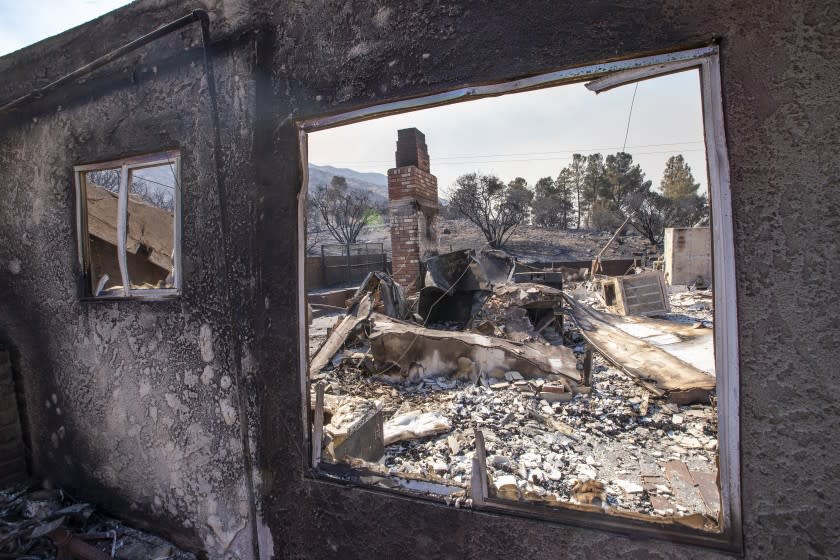California bans insurers from dropping coverage for 2.1 million homes in fire-stricken areas

With parts of California still smoldering, the state Department of Insurance has issued a one-year moratorium prohibiting insurers from canceling or not renewing about 2.1 million homeowners’ policies, the second consecutive year policyholders in or near fire-stricken areas have gotten a temporary measure of relief.
The move will temporarily protect homeowner policies in select ZIP Codes from Siskiyou to San Diego counties.
“Losing your insurance should be the last thing on someone’s mind after surviving a devastating fire,” said Insurance Commissioner Ricardo Lara in a statement Thursday. “My action gives millions of Californians breathing room and hits the pause button on insurance non-renewals while we take additional steps to expand our competitive market.”
Repeated, destructive wind-driven fires in forest and foothill communities have been bleeding billions of dollars of insurance provider profits in recent years, leading them to spike premiums or flee the marketplace altogether.
In 2020 alone, wildfires have burned across 4 million acres of local, state and federal land — more than twice the state’s previous record — destroying thousands of homes and killing at least 30 people.
Lara’s order affects homeowner policies in and adjacent to state-declared disaster zones from this year’s wildfires and includes homeowners in the following counties: Butte, Fresno, Lake, Los Angeles, Madera, Mariposa, Mendocino, Napa, Nevada, Monterey, Plumas, San Bernardino, San Diego, San Mateo, Santa Clara, Santa Cruz, Siskiyou, Solano, Stanislaus, Yolo and Yuba.
It’s the second moratorium Lara has issued since taking office in 2019 and though the initial move elicited concerns it would dissuade insurers from covering homes in fire-vulnerable areas, two major insurance groups have said they are complying with the order. A 2018 study showed humans continue to settle despite the increased fire risks.
In a joint statement, the American Property Casualty Insurance Assn. and Personal Insurance Federation of California said it’s time they “adapt to this new reality.”
“We hope to work collaboratively on comprehensive solutions to better account for increased wildfire risk in homeowners coverage, which will increase availability of insurance,” the statement said. “While changing the trajectory of climate change will take time, we need to take action now to make our communities more resilient and protect the lives and property of all Californians.”
About 413,000 of last year’s protected policyholders will be protected again under Lara’s new order, though some 600,000 will not.
Beyond the moratorium, Lara’s office is working with insurance providers and consumer advocates and others to find agreement on how to stabilize the state’s insurance market, which is the fourth largest in the world.
Over the last three years, a number of issues both macro and micro, from climate change to California’s housing costs and availability, have converged head-on in the state’s wildland-urban interface where the suburbs blend into rugged mountain terrain.
Residents are seeing policy premiums jump by hundreds of percent a year while others are opting to quietly forgo coverage altogether. Still others have turned to the secondary market, which has fewer consumer protections, or to the state’s plan for high-risk policies which is more expensive and offers less coverage.
Between 2018 and 2019, there was a 31% increase in homeowner policy non-renewals statewide and a 61% increase in areas deemed at moderate or very high risk of fire, according to state data. The worst-hit counties watched insurers refuse to renew policies at an even greater clip while those that remained jacked up their policy premiums.
To stem the rising tide against homeowners, Lara’s office announced earlier this year that changes were coming down the pike for insurers, including a requirement that they offer an incentive for homeowners who reduce fire risks on their property and greater transparency in how insurers calculate their risks and justify their premiums.
A second hearing on the possible changes is scheduled for Dec. 10.
“If we don’t want to be in this position every year, we have to reduce the risk to lives and homes, which means everyone plays a part — homeowners and state and local governments through home-hardening, the federal government through forest management, and the insurance industry working as a partner,” the commissioner’s statement said.
This story originally appeared in Los Angeles Times.

